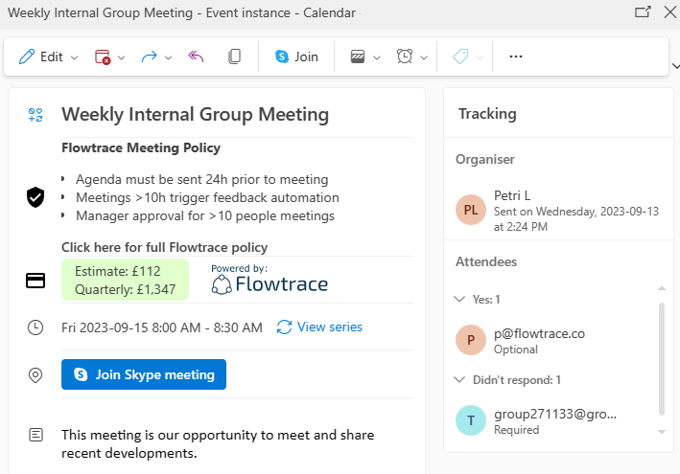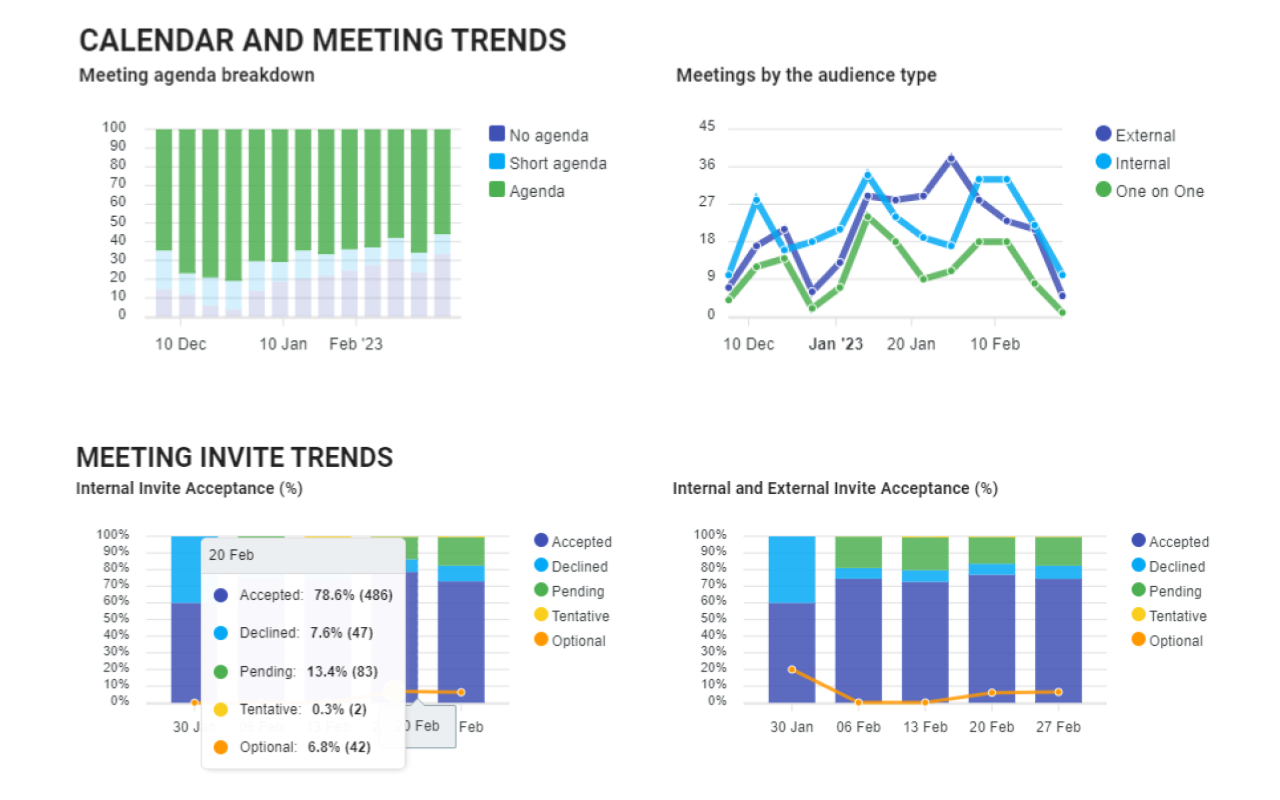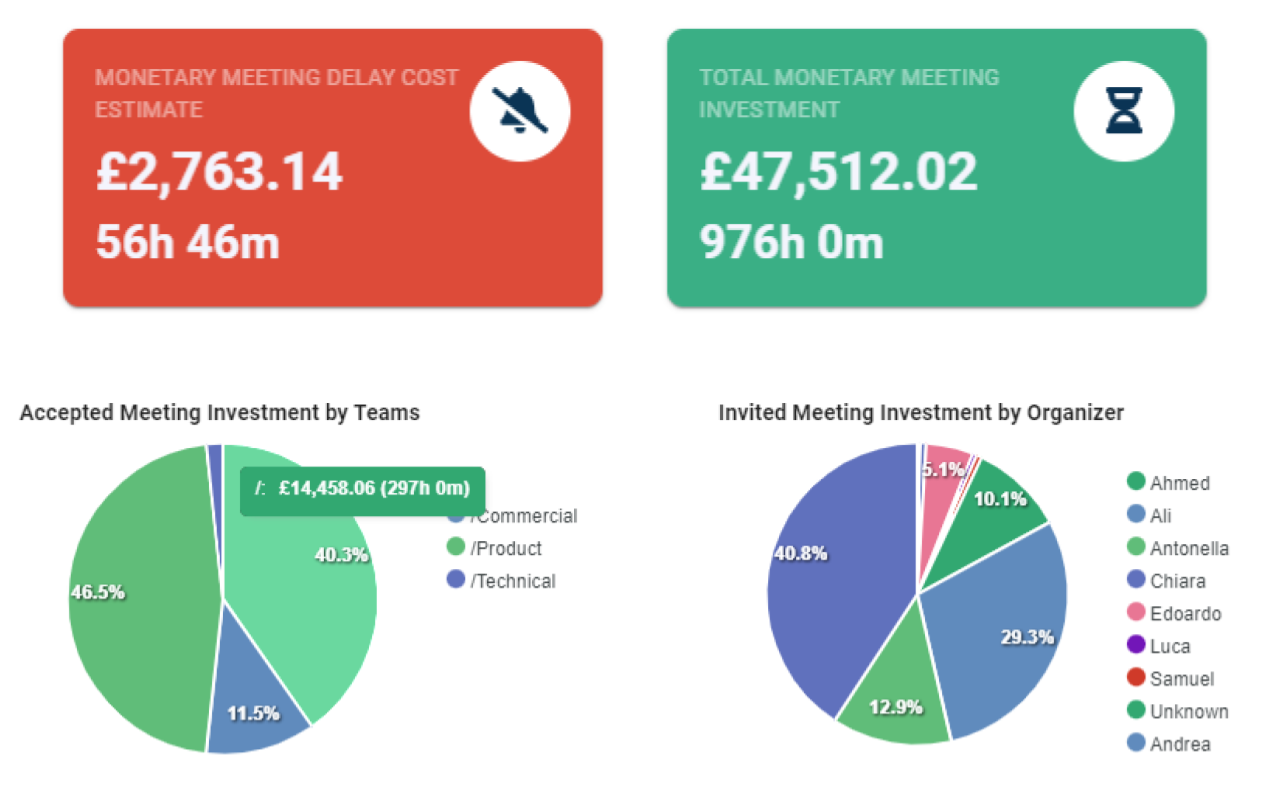Benefits of No Meeting Days
Increase your workplace productivity with the benefits of no-meeting days. Enhance focus, boost employee productivity, and improve well-being with...
Understanding the average time in meetings is crucial for productivity. Discover the impact on employee productivity and the financial implications.
When striving for optimal productivity and effective time management, understanding the average time spent in meetings is essential. The role of meetings as both a collaborative tool and a potential time sink cannot be understated.
By implementing calendar analysis, a strategic approach to dissecting and optimizing how time, especially in meetings, is utilized within a company leaders can pave the way for smarter, data-driven decisions to enhance overall organizational performance. A key aspect in this is understanding from a company perspective, the average time in in meetings.
Meetings are an inescapable reality, often dictating the pace and outcome of workdays. Recent statistics paint a picture of this pervasive meeting culture. In the United States alone, approximately 55 million meetings are held each week, highlighting their important role in the corporate world. This staggering number equates to over 1 billion meetings annually, reflecting the growing number of meetings in professional settings.
However, quantity does not necessarily equate to quality. A significant portion of these meetings may not be as productive as intended. An average employee is reported to spend about 3 hours per week in meetings, with 30% of workers indicating that their meeting time exceeds 5 hours weekly. This time investment is substantial, but the concern deepens when considering the productivity of these meetings.
It's estimated that organizations devote around 15% of their collective time to meetings, yet a striking 71% of these meetings are deemed unproductive. This inefficiency translates into a considerable loss, both in terms of time and financial resources. An estimated $37 billion is lost annually to unproductive meetings, a figure that underscores the imperative need for more effective meeting management and optimization.
The impact is not just confined to wasted hours; it also extends to the overall productivity of the workforce. With 24 billion hours lost each year as a result of unproductive meetings, the cost to organizations is immense. Not only does this represent a significant portion of potentially productive work hours lost, but it also reflects a substantial financial burden to businesses.
In a corporate environment where efficiency and productivity are paramount, these statistics highlight the urgent need for a more strategic approach to managing and conducting meetings. This scenario calls for a reevaluation of meeting practices and a more judicious use of time, making calendar analysis an invaluable tool in the goal of organizational efficiency and effectiveness.
The impact of meetings on employees extends beyond just time allocation, it significantly influences their sentiments and productivity. A noteworthy 65% of employees concur that meetings can be a barrier to completing their work. This statistic is hardly surprising when considering that higher-ranking employees, such as those in executive roles, can spend up to 50% of their time in meetings. Such extensive time commitment to meetings leaves less room for individual work, often leading to delayed tasks and extended work hours.

Additionally, the meeting frequency can be overwhelming for many. Around 45% of employees report feeling inundated by the sheer number of meetings they are required to attend. This sense of overwhelm can lead to reduced job satisfaction and increased stress, factors that directly impact employee morale and productivity. The situation is exacerbated when meetings are perceived as unproductive or unnecessary, contributing to a sense of frustration and inefficiency among the workforce.
Multitasking in meetings is another concern, with employees engaging in other activities, such as email checking, during meetings. This behavior, prevalent in at least 41% of meetings, is often a coping mechanism to manage workload and is more likely to occur in longer meetings. However, it can detract from the effectiveness of the meeting itself and further dilute the focus and productivity of the employees involved.
These insights into employee sentiments underline the critical need for organizations to reassess their meeting culture. It is essential to strike a balance between necessary collaboration and respect for individual work time to maintain a productive, engaged, and motivated workforce.
The burden of meetings is most noticed among leadership roles. A striking example is the average CEO, who reportedly spends as much as 72% of their time in meetings. This equates to at least 37 meetings per week, a significant allocation of their workweek to such engagements.
Middle management is not spared either. These employees spend roughly 35% of their time in meetings, while upper management dedicates about 50% of their time to these sessions. The sheer volume of meetings at these levels often eclipses time available for strategic planning, decision-making, and leadership responsibilities.
Office jobs, especially those at the vice president level and above, tend to have the most meetings. Vice Presidents and CEOs average about 17 meetings per week, which is 53% more than the average employee who attends around eight meetings weekly.
This disproportionate impact on leadership highlights a critical challenge: balancing the need for managerial oversight and decision-making with the equally important tasks of strategic planning and organizational leadership.
The excessive time spent in meetings by senior staff can inadvertently lead to a bottleneck in decision-making and a potential slowdown in organizational responsiveness. Addressing this imbalance is crucial for maintaining operational efficiency and fostering a productive work environment.

The economic cost of inefficient meeting practices is substantial. In the United States, businesses collectively lose an estimated $37 billion annually due to unnecessary meetings. This figure is not just a reflection of time misspent; it represents a significant loss in productivity and resource allocation. To put this in perspective, these unproductive meetings account for approximately 300,000 hours of work each year, a staggering amount of potential output lost.
Even a single large business can lose up to $300 million on ineffective meetings. This financial impact extends beyond the direct costs of conducting meetings and includes the opportunity cost of what could have been achieved with more efficient use of time. This scenario highlights the need for organizations to re-evaluate their meeting strategies and consider more effective approaches to time management to mitigate these substantial losses.
The efficacy of meetings hinges significantly on their structure and management. One key element of effective meetings is the use of agendas, yet surprisingly, only 37% of workplace meetings actively utilize them. Agendas play a crucial role in guiding discussions, keeping participants on track, and ensuring that meetings are purposeful and time-efficient.

Effective meeting management involves more than just agendas. It includes setting clear objectives, inviting only necessary participants, and being mindful of the meeting duration. A structured approach ensures that meetings are not just a routine procedure but a productive tool for decision-making and collaboration.
Furthermore, preparation time is an often overlooked aspect of meetings. Employees and managers typically spend an equal amount of time preparing for a meeting as they attend it. This means that a 30-minute meeting might entail another 30 minutes of preparation. Understanding and optimizing this preparation time is vital for improving overall meeting efficiency and effectiveness.
Flowtrace specializes in providing data-driven insights into meeting patterns and behaviors within organizations. By analyzing calendar data, Flowtrace identifies trends such as meeting overload, unproductive time slots, and inefficient scheduling. This analysis is crucial in understanding how meetings impact overall productivity and where improvements can be made.

These meeting analytics goes beyond analysis by offering feedback, actionable date and also actionable recommendations. These suggestions are tailored to optimize meeting efficacy, enhance collaborative processes, and streamline workflows.
This allows leaders can transition from a reactive to a proactive stance in managing meeting culture, ensuring that every meeting is purposeful, productive, and aligned with organizational goals. This strategic approach to meeting management, powered by data and analytics, can significantly uplift an organization's productivity and efficiency.
In exploring the tangible impacts of reduced meeting times and enhanced productivity through calendar analysis, several real-world examples stand out.
To optimize meeting culture, leaders can implement several strategies using data and tools:
In conclusion, understanding and managing meeting time is crucial for organizational success. By adopting calendar analysis tools and strategies, leaders can drive productivity, enhance decision-making, and foster a more engaged and efficient workforce. Embracing these tools not only illuminates current practices but also paves the way for a more strategic, data-driven approach to meetings, ensuring they add value and propel the organization forward.
Increase your workplace productivity with the benefits of no-meeting days. Enhance focus, boost employee productivity, and improve well-being with...
Transform company meetings for enhanced productivity and engagement. Learn how to optimize meeting culture, reduce overload, and drive success...
Discover how meeting-free days can enhance productivity and employee well-being in organizations, and how to effectively implement them.